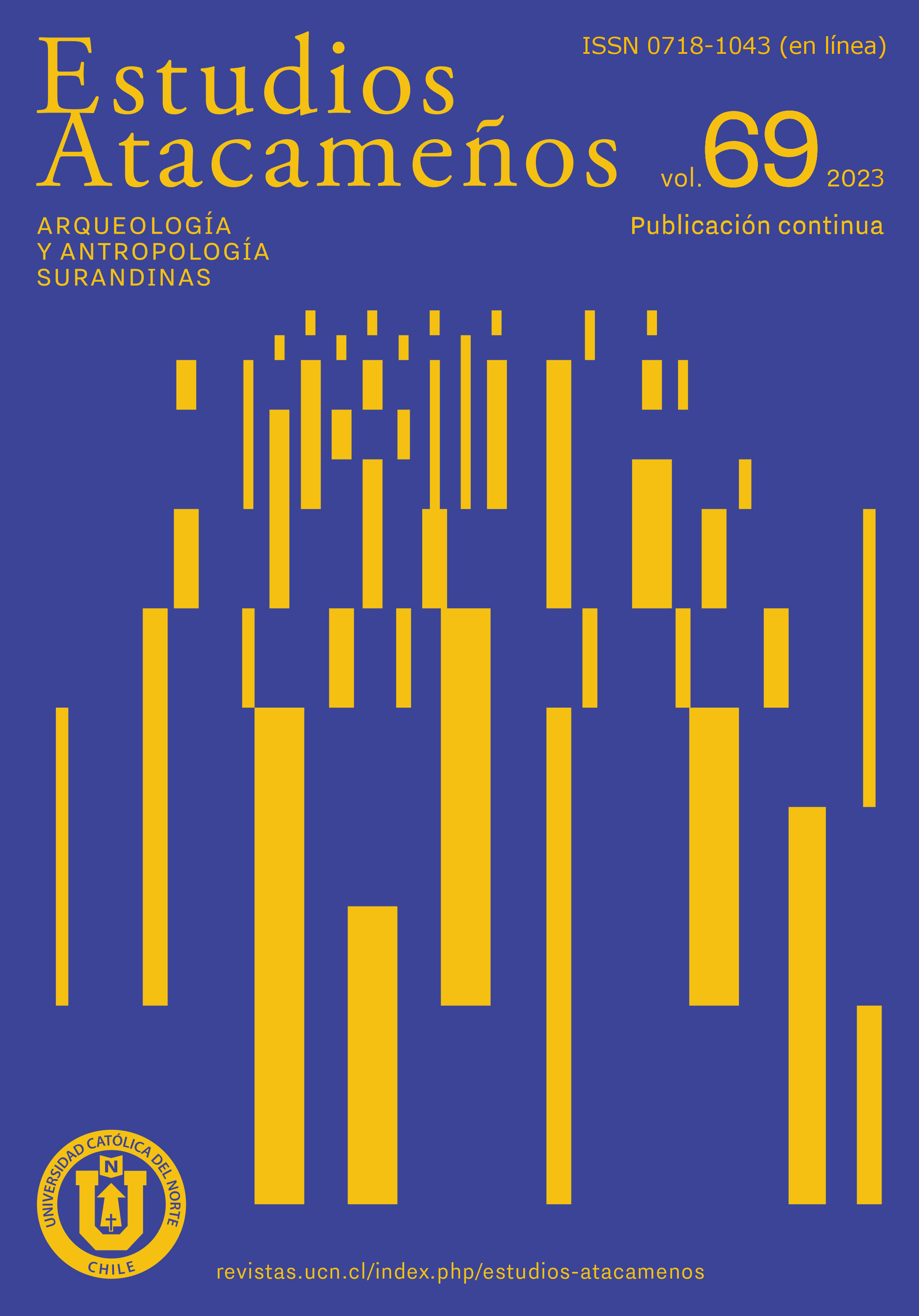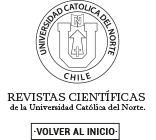"The devil has settled in the Salar"
Atacameño Organizations, water and lithium mining in the Atacama salt flat
DOI:
https://doi.org/10.22199/issn.0718-1043-2023-0004Keywords:
collective action, decarbonisation, inequalities, water miningAbstract
The capital and mining that has been in the Antofagasta region since the late 19th century brought profound social and environmental transformation. The deep-rooted process finds continuity and expansion in today’s lithium mining of the Atacama salt flats (Salar de Atacama). The ethnic dimension of collective action in this territory since the 1990s has redefined intercultural relations. In the second decade of this century, mining companies and Atacameño organizations agreed to direct money transfers as compensation for the negative impacts of mining operations, especially on the water balance. The communities’ negotiation and territorial management strategies have raised strong questioning within and among Atacameño organizations, shifting the traditional communities vs. companies conflict to within the indigenous organizations. This article describes this new stage of Atacameño organization and mobilization.
Downloads
References
Albemarle. (16 de septiembre de 2019). Albemarle y Consejo de Pueblos Atacameños exponen en Sustainable Mining 2019. https://bit.ly/3HKQY5H
Anlauf, A. (2015). ¿Secar la tierra para sacar litio? Conflictos socio-ambientales en la minería del litio. En F. Nacif y M. Lacabana (Coord.), ABC del litio sudamericano. Soberanía, ambiente, tecnología e industria (pp. 171-191). Centro Cultural de la Cooperación Floreal Gorini – Universidad Nacional de Quilmes.
Angé, O. y Berliner, D. (2015). Introduction: Anthropology of Nostalgia – Anthropology as Nostalgia. (2015). En O. Angé y D. Berliner (Eds.), Anthropology and Nostalgia (pp. 1-16). Berghahn.
Akchurin. M. (2020). Mining and Defensive Mobilization: Explaining Opposition to Extractive Industries in Chile. Sociology of Development, 6(1), 1-29. https://doi.org/j8q2
Argento, M., Slipak, A. y Puente, F. (2022). Litio, transición energética, economía política y comunidad en América Latina. En L. Sablich (Coord.), Ambiente, cambio climático y buen vivir en América Latina y el Caribe (pp. 441-520). CLACSO. https://bit.ly/44usLu5
Azócar, V. y Cárdenas, L. (21 de agosto de 2020a,). $1.700 millones por la paz en el Salar de Atacama: SQM llega a acuerdo con comunidad indígena en proceso por uso de aguas. La Tercera. https://bit.ly/3HIMlco
Azócar, V. y Cárdenas, L. (26 de agosto de 2020b). Acuerdo de SQM con Camar tensiona a comunidades: Peine y Consejo de Pueblos Atacameños no negociarán con la firma. La Tercera. https://bit.ly/417NaSL
Babidge, S. (2013). “Socios”: The Contested Morality of “Partnerships” in Indigenous Community–Mining Company Relations, Northern Chile. The Journal of Latin American and Caribbean Anthropology, 18(2), 274-313. https://doi.org/10.1111/jlca.12020
Bebbington A., Humphreys Bebbington D., Bury, J., Lingan, J., Muñoz, J.P. y Scurrah, M. (2008). Mining and Social Movements: Struggles Over Livelihood and Rural Territorial Development in the Andes. World Development, 36(12), 2888-2905. https://doi.org/10.1016/j.worlddev.2007.11.016
Benavides, C. y Sinclaire, D. (2014). El convenio minero en tierras indias el oasis de Peine y la gran minería en la cuenca del Salar de Atacama. Revista rufián, (19), 31-39. https://bit.ly/3nBEtCM
Blair, J. (2021). Extractivismo del litio y el problema de la escala: Acción climática global y justicia ambiental local. En Observatorio Plurinacional de Salares Andinos. Salares Andinos. Ecologías de saberes por la protección de nuestros salares y humedales (pp. 83-95). Fundación Tantí – OPSAL.
Boelens, R., Cremers, L. y Zwarteveen, M. (2011). Justicia Hídrica. Acumulación, Conflicto y Acción Social. Instituto de Estudios Peruanos.
Bolados, P. (2014). Los conflictos etnoambientales de ‘Pampa Colorada’ y ‘El Tatio’ en el Salar de Atacama, norte de Chile. Procesos étnicos en un contexto minero y turístico transnacional. Estudios Atacameños, (48), 229-248. https://doi.org/j8q6
Bolados, P. y Babidge, S. (2017). Ritualidad y extractivismo: La limpia de canales y las disputas por el agua en el Salar de Atacama-norte de Chile. Estudios Atacameños, (54), 201-216. https://bit.ly/3VD13ap
Bond, P. y Dorsey, M.K. (2010). Anatomies of environmental knowledge y resistance: Diverse climate justice movements and waning eco-neoliberalism. Journal of Australian Political Economy, (66), 286-316. https://bit.ly/3M0ECsw
Bullard, R., Mohai, P., Saha, R. y Wright, B. (2007). Toxic Wastes and Race at Twenty 1987-2007. United Church of Christ.
Bustos, C. (2011). Grupos originarios, patrimonio cultural y turismo indígena en el desierto de Atacama (Chile). En L. Prats y A. Santana (Coord.), Turismo y patrimonio, entramados narrativos (pp. 49-62). Asociación Canaria de Antropología.
Calderón, M., Benavides, C., Carmona, J., Gálvez, D., Malebrán, N., Rodríguez, M., Sinclaire, D. y Urzúa, J. (2016). Gran minería y localidades agrícolas en el norte de Chile: Comparación exploratoria de tres casos. Chungará (Arica), 48(2), 295-305. https://doi.org/j8q9
Campos-Ortega, C. y Jorquera-Jaramillo, C. (2008). Minería y conservación en Atacama. En F. Squeo; G. Arancio y J. R. Gutiérrez (Eds.), Libro rojo de la flora nativa y de los sitios prioritarios para su conservación: Región de Atacama (pp. 323-338). Universidad de La Serena.
Carrasco, A. (2016). A Biography of Water in Atacama, Chile: Two Indigenous Community Responses to the Extractive Encroachments of Mining. The Journal of Latin American and Caribbean Anthropology, 21(1), 130-150. https://doi.org/10.1111/jlca.12175
Carrère, Michelle (22 de enero de 2019) Chile: detienen proceso sancionatorio de SQM acusada de graves infracciones ambientales. Mongabay. https://bit.ly/3HF4APS
Castillo, M. (2016). Socio-Ecological Inequality and Water Crisis: Views of Indigenous Communities in the Alto Loa Area. Environmental Justice, 9(1), 9-14. https://doi.org/gk6jd7
CINPRO Consultores. (1997). Ordenamiento catastral de las comunidades indígenas del altiplano de la II Región, Provincia de El Loa (Informe final). CONADI – Ministerio de Bienes Nacionales.
Comisión Económica para América Latina y el Caribe y Organización para la Cooperación y el Desarrollo Económicos. (2016). Evaluaciones del desempeño ambiental: Chile 2016. CEPAL.
Conde, M. (2017). Resistance to mining: A review. Ecological Economics, (132), 80-90. https://doi.org/10.1016/j.ecolecon.2016.08.025
Cuadra, M. (2000). Teoría y práctica de los derechos ancestrales de agua de las comunidades atacameñas. Estudios Atacameños, (19), 93-112. https://doi.org/gm545f
DATURA Consultores. (1998). Delimitación de los territorios comunitarios y patrimoniales de las comunidades indígenas de la Provincia de El Loa y patrones de ocupación. CONADI – Ministerio de Bienes Nacionales.
Dawson, A. (2010). Climate justice: the emerging movement against green capitalism. South Atlantic Quarterly, 109(2), 313-338. https://doi.org/10.1215/00382876-2009-036
Decreto Ley N° 70. Declara área de desarrollo indígena la zona que indica. Diario Oficial de la República de Chile, Santiago, 23 de abril de 1997. http://bcn.cl/2h4pe
Fernandes, B.M. (2005). Movimentos socioterritoriais e movimentos socioespaciais. Observatorio Social de América Latina, 6(16), 273-284. https://bit.ly/41aTxVE
Folchi, M. (2001). Conflictos de contenido ambiental y ecologismo de los pobres: no siempre pobres, ni siempre ecologistas. Ecología Política, (22), 79-100. https://bit.ly/3HIttKs
Gajardo, G. y Redón, S. (2019). Andean hypersaline lakes in the Atacama Desert, northern Chile: Between lithium exploitation and unique biodiversity conservation. Conservation Science and Practice, 1(19); e94. https://doi.org/10.1111/csp2.94
Garcés, I. y Alvarez, G. (2020). Water mining and extractivism of the Salar de Atacama, Chile. WIT Transactions on Ecology and the Environment, (245), 189-199. https://doi.org/gjp9ww
Göbel, B. (2013). La minería del litio en la Puna de Atacama: Interdependencias transregionales y disputas locales. Iberoamericana, 13(49), 135-149. https://doi.org/h5ht
Gundermann, H. (2003). Sociedades indígenas, municipio y etnicidad: La transformación de los espacios políticos locales andinos en Chile. Estudios Atacameños, (25), 55-77. https://dx.doi.org/10.4067/S0718-10432003002500004
Gundermann, H. y Göbel, B. (2018). Comunidades indígenas, empresas del litio y sus relaciones en el Salar de Atacama. Chungará (Arica), 50(3), 471-486. https://doi.org/h5hv
Homer-Dixon, T. F. (1999). Environment, Scarcity and Violence. Princeton University.
Houston, J. (2006). Variability of precipitation in the Atacama Desert: Its causes and hydrological impact. International Journal of Climatology, (26), 2181-2198. https://doi.org/fkrb4j
Houston, J. y Hartley, A. J. (2003). The central Andean west-slope rainshadow and its potential contribution to the origin of hyper-aridity in the Atacama Desert. International Journal of Climatology, (23), 1453-1464. https://doi.org/10.1002/joc.938
Hund, K., La Porta, D., Fabregas, T.P., Laing, T. y Drexhage, J. (2020). Minerals for Climate Action: The Mineral Intensity of the Clean Energy Transition. World Bank Group. https://bit.ly/42v6lHd
Innerarity, D. (2012). Justicia climática. Dilemata, (9), 175–191. https://bit.ly/415yt2F
Janvry de, A. (1981). The Agrarian Question and Reformism in Latin America. John Hopkins University.
Jerez, B., Garcés, I. y Torres, R. (2021). Lithium extractivism and water injustices in the Salar de Atacama, Chile: The colonial shadow of green electromobility. Political Geography, (87). https://doi.org/10.1016/j.polgeo.2021.102382
Lerner, S. (2010). Sacrifice Zones: The Front Lines of Toxic Chemical Exposure in the United States. The MIT.
Liu, W. y Agusdinata, D. (2020). Interdependencies of lithium mining and communities sustainability in Salar de Atacama, Chile. Journal of Cleaner Production, 260: 120838. https://doi.org/10.1016/j.jclepro.2020.120838
Liu, W., Agusdinata, D. y Myint, S. (2019). Spatiotemporal patterns of lithium mining and environmental degradation in the Atacama Salt Flat, Chile. International Journal of Applied Earth Observation and Geoinformation, 80, 145-156. https://doi.org/gnpxwk
Llagostera, A. (2011). Los antiguos habitantes del Salar de Atacama. Pehuen.
Maillet, A., Allain, M., Delamaza, G., Irarrazabal, F., Rivas, R., Stamm, C. y Viveros, K. (2021). Conflicto, territorio y extractivismo en Chile. Aportes y límites de la producción académica reciente. Revista de geografía Norte Grande, (80), 59-80. https://doi.org/jgsc
Margaleff, R. (1983). Limnología. Omega.
Marquet, P., Bozinovic, F., Bradshaw, G., Cornelius, C., González, H., Gutiérrez, J., Hajek, E., Lagos, J., López-Cortés, F., Núñez, L., Rosello, E., Santoro, C., Samaniego, H., Standen, V., Torres-Mura. J. y Jaksic, F. (1998). Los ecosistemas del desierto de Atacama y área andina adyacente en el norte de Chile. Revista Chilena de Historia Natural, 71(4), 593-617. https://bit.ly/42adv41
Martínez-Alier, J. (2004). El ecologismo de los pobres. Conflictos ambientales y lenguajes de valoración. Icaria.
Martínez-Tilleria, K.; Núñez-Ávila, M.; León, C.; Pliscoff, P.; Squeo, F. y Armesto, J. (2017). A framework for the classification Chilean terrestrial ecosystems as a tool for achieving global conservation targets. Biodiversity and Conservation, 26(12), 2857–2876. https://doi.org/10.1007/s10531-017-1393-x
Mohai, P., Pellow, D. y Roberts, J.T. (2009). Environmental Justice. Annual Review of Environment and Resources, 34(1), 405-430. https://doi.org/d8cqwx
Morales, H. (2014). Génesis, formación y desarrollo del movimiento atacameño (norte de Chile). Estudios Atacameños, (49), 11-128. https://dx.doi.org/10.4067/S0718-10432014000300007
Morales, H. y Azócar, R. (2015). Minería y relaciones interétnicas en Atacama. Estudios Atacameños, (51), 49-63. https://bit.ly/417wtqH
Pavlovic, P. (2014). La industria del litio en Chile. Ingenieros (Santiago), (209), 30-35. https://bit.ly/429nUgu
Pettit, J. (2004). Climate justice: A new social movement for atmospheric rights”. IDS Bulletin, 35(3), 102-106. https://doi.org/10.1111/j.1759-5436.2004.tb00142.x
Prieto, M. (2017). La ecología (a) política del modelo de aguas chileno. En B. Bustos, M. Prieto y J. Barton (Eds.), Ecología política en Chile. Naturaleza, propiedad, conocimiento y poder (pp. 143-166). Universitaria.
Prieto, M. y Sandoval, G. (2018). Expansión de la extracción de salmuera en el Salar de Atacama. San Pedro de Atacama (Informe). Resarchgate. https://doi.org/j8rc
Rivera, F. (1994). Identidad en el laberinto: La búsqueda del sentido étnico en San Pedro de Atacama. Estudios Atacameños, (11), 187-196. https://doi.org/j7kj
Rodríguez, E. (Ed.). (2006). Conservación de flamencos altoandinos en el Norte de Chile: Estado actual y plan de conservación. Corporación Nacional Forestal. https://bit.ly/42wn3Gv
Romero, H., Méndez, M. y Smith, P. (2012). Mining Development and Environmental Injustice in the Atacama Desert of Northern Chile. Environmental Justice, 5(2), 70-76. https://doi.org/10.1089/env.2011.0017
Romero, H. y Opazo, D. (2019). El ayllu como territorio de vida en las comunidades altoandinas y su relación con la configuración espacial de la minería en el desierto y Salar de Atacama, Norte de Chile. Ambientes (Francisco Beltrão), 1(1), 38-78. https://doi.org/j8rf
Schlosberg, D. (2004). Reconceiving Environmental Justice: Global Movements and Political Theories. Environmental Politics, 13(3), 517-540. https://doi.org/dv3kpd
Schlosberg, D. (2007). Defining environmental justice: theories, movements and nature. Oxford University. https://doi.org/10.1093/acprof:oso/9780199286294.001.0001
Sharma, S. y Manthiram, A. (2020). Towards more environmentally and socially responsible batteries. Energy & Environmental Science, 13(11), 4087-4097. https://doi.org/gpm59b
Souza Santos, B. de (2009). Una epistemología del sur. La reinvención del conocimiento y la emancipación social. Siglo XXI – CLACSO.
Sovacool, B. (2021). Who are the victims of low-carbon transitions? Towards a political ecology of climate change mitigation. Energy Research & Social Science, 73: 101916. https://doi.org/10.1016/j.erss.2021.101916
Svampa, M. (2019). Las fronteras del neoextractivismo en América Latina: Conflictos socioambientales, giro ecoterritorial y nuevas dependencias. CALAS.
Videla, S. (2021) Historia del agua en el Norte Grande. Siglo XIX. Universidad de Concepción.
Ward, D. (2009). The Biology of Deserts. Oxford University.
Wurtsbaugh, W., Miller, C., Null, S., Justin DeRose, R., Wilcock, P., Hahnenberger, M., Howe, F. y Moore, J. (2017). Decline of the World's Saline Lakes. Nature Geoscience, 10(11), 816-821. https://doi.org/10.1038/ngeo3052
Yáñez, N. y Molina, R. (2008). La gran minería y los derechos indígenas en el norte de Chile. LOM.
Yáñez, N. y Molina, R. (Comp.). (2011). Las aguas indígenas en Chile. LOM.
Zwarteveen, M.Z. y Boelens, R. (2014). Defining, researching and struggling for water justice: some conceptual building blocks for research and action. Water International, 39(2), 143-158. https://doi.org.10.1080/02508060.2014.891168
Downloads
Published
Issue
Section
License
Copyright (c) 2023 Mauricio Lorca, Manuel Olivera, Ingrid Garcés

This work is licensed under a Creative Commons Attribution 4.0 International License.

All works published in Revista Estudios Atacameños (ISSN on line:0718-1043) Revista Estudios Atacameños Creative Commons International 4.0 attribution (CC BY 4.0) licence.
Authors remain the owners of their work and may republish their articles elsewhere without having to request permission, as long as they indicate that the work was originally published in Revista Estudios Atacameños (ISSN on liine:0718-1043).












